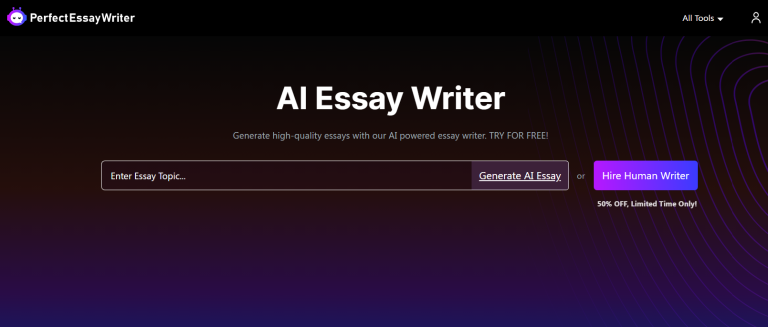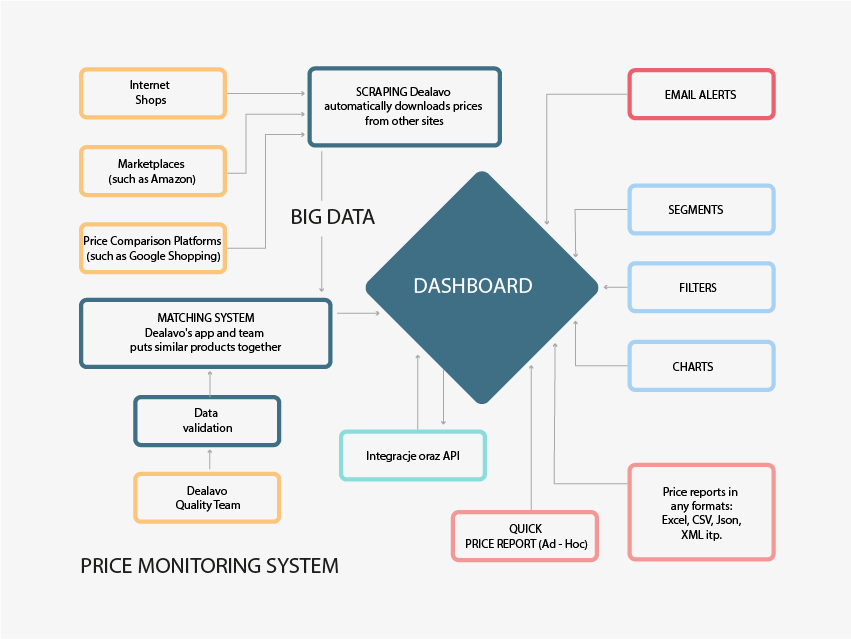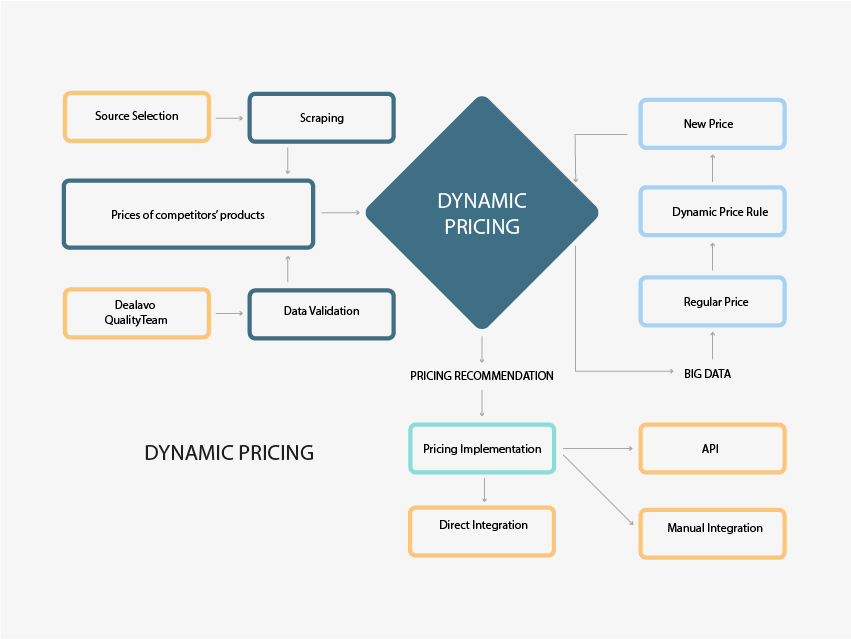In the current time, when crafting quality content is more important than ever, many find themselves stuck in an endless loop of brainstorming, researching, and editing. This process, though necessary, can be exhausting, time-consuming, and often frustrating.
Enter PerfectEssayWriter.ai—an up-to-date writing platform designed to simplify and uplift content creation for diverse audiences.
With its impressive range of AI-powered tools, the platform bridges the gap between efficiency and creativity. It makes it easier than ever to produce polished, impactful content in a fraction of the time.
The next sections explore its standout offerings, showcasing how this platform delivers exceptional versatility.
A Rich Library Of 25+ AI Writing Tools
PerfectEssayWriter.ai stands out as a top-notch platform for those seeking AI to write a paper, craft compelling content, or improve their writing projects with unmatched precision.
The platform’s universal library of AI tools is designed to cater to various needs, making it a reliable choice for scholars, professionals, and content creators. Here’s a closer look at some of its most remarkable features.
Tools That Deliver Precision & Accuracy
PerfectEssayWriter.ai includes advanced tools like the AI Detector, which identifies AI-generated content with impressive accuracy. This promises originality and authenticity in any document.
Complementing this is the AI Humanizer, which refines robotic-sounding text into natural and engaging language. It is surely a valuable asset for professionals aiming to create relatable content.
For grammar perfection, the Grammar Checker is a must-have, swiftly identifying and correcting errors with remarkable precision.
Besides, academic users will find immense value in the Citation Machine, which simplifies the often tedious task of generating accurate citations in multiple formats.
Adding to this is the Thesis Statement Generator, an essential tool for constructing strong, focused statements to frame academic papers effectively.
More Tools For Everyday Writing Needs
Beyond these highlights, PerfectEssayWriter.ai offers a Paraphrasing Tool, Plagiarism Checker, and Summarizer, each designed to make content creation seamless.
Whether someone needs to rewrite content, ensure originality, or condense large documents into key points, these tools work efficiently to deliver high-quality results.
Customization & Innovation Guaranteed
PerfectEssayWriter.ai takes user input seriously, allowing individuals to choose a tool that suits their needs or even request the addition of new tools. With the option to share detailed suggestions, the platform continuously updates to address numerous writing challenges.
This adaptability and user-focused approach make PerfectEssayWriter.ai a comprehensive solution for anyone aiming to refine their writing with ease.
PerfectEssayWriter.ai’s AI Essay Writer: Human-Like Essays In Seconds
The AI essay writer offered by PerfectEssayWriter.ai is modifying the way essays are crafted. By blending innovative technology with intuitive functionality, this tool has become a trusted choice for over 2 million users worldwide.
Whether it’s for academic purposes, professional work, or creative writing, this essay generator confirms high-quality, plagiarism-free, and human-like content. And what’s best, it does this only in a matter of seconds—all without the need for sign-up.
Key Features Of This AI Essay Writer
- Adjustable Academic Level & Page Count: The tool allows users to customize their essays based on academic level and length. It hassle-freely caters to specific requirements for high school, undergraduate, or advanced-level writing.
- Versatile Subject Coverage: From humanities to STEM, the essay generator covers all fields of study, providing well-researched and relevant content across various disciplines.
- Plagiarism-Free & Undetectable Content: What sets this tool apart is its ability to produce essays that mimic natural human writing. This makes them virtually undetectable by AI detectors. Each piece is also plagiarism-checked to guarantee originality.
- Citations & Customization: With built-in support for references, citations, and real-time editing, this tool streamlines the essay-writing process. Its “Special Instructions” feature allows users to describe their preferences, certifying tailored results.
- Quick Yet Reliable Research Insights: The AI gathers and organizes insights rapidly. This helps in creating essays with clear introductions, structured arguments, and cohesive conclusions that reflect thoughtful writing.
Why It’s A Top Choice For Students & Professionals
PerfectEssayWriter.ai is an ideal essay writer for users seeking precision and personalization, combining advanced AI algorithms with customizable options.
By adjusting the tone, style, and structure of the content, the tool makes certain that essays feel authentic and aligned with the writer’s goals. Its speed and accuracy, paired with intuitive features, make it an unparalleled asset for both academic and professional settings.
Sample Essays Generated By This Essay Writer
To truly understand the capabilities of PerfectEssayWriter.ai’s AI Essay Writer, one only needs to explore the example essays it has generated.
The examples available on the website showcase the tool’s ability to craft essays with a clear structure, compelling arguments, and a natural, human-like flow.
Covering a variety of topics across multiple fields, the samples highlight the precision, creativity, and depth that this AI-powered tool brings to every piece. Whether for academic or creative purposes, these essays provide a glimpse into how effectively the platform turns a simple topic into a polished, well-researched masterpiece.
Readers are encouraged to take a look at these samples for inspiration and see firsthand how effortlessly the tool handles complex ideas and various writing styles.
PerfectEssayWriter.ai’s Flexible Pricing Plans For Every Budget
The pricing for PerfectEssayWriter.ai is thoughtfully structured to cater to a wide range of users, from students with tight budgets to professionals seeking premium tools. Its flexibility implies that everyone can leverage the power of AI-driven essay writing without financial strain.
The platform offers a free plan to get started, requiring no credit card, making it an excellent choice for first-time users. For those looking to unlock advanced features, subscription plans are available at affordable rates.
| Plan |
Cost |
| Starter |
$0 |
| Basic |
$9.99/month |
| Pro |
$14.99/month |
| Advanced |
$99.99/year |
By subscribing to a plan, users can enjoy powerful features like unlimited essay generation, enhanced access to tools, and in-depth content analysis. These capabilities streamline the writing process, enabling subscribers to create polished papers quickly and efficiently.
Whether it’s a free trial or a premium subscription, PerfectEssayWriter.ai secures quality, affordability, and flexibility.
PerfectEssayWriter.ai’s Recently Launched Google Chrome Extension
It’s a new plugin that brings the power of AI writing and content verification directly to the browser. With its effortless integration, this extension simplifies writing tasks by offering both an advanced AI essay writer and a handy AI content detector—all within a few clicks.
Key Offerings
- AI Essay Writer: The AI essay writer generates ideas instantly and creates structured, coherent content that adapts to individual writing styles. It provides clarity, coherence, and optimal results, saving significant time and effort.
- AI Content Detector: The built-in AI content detector provides detailed reports, offering accurate percentages of AI versus human-generated text. It can even detect mixed or rephrased content, making it a reliable tool for protecting authenticity.
With over 1.3 million users and the ability to generate results within seconds, this extension is ideal for anyone using the Google Chrome browser.
While the extension is currently exclusive to the Google Chrome browser, future updates may expand compatibility to other browsers, ensuring even broader accessibility for users worldwide.
Hire A Human Writer At PerfectEssayWriter.ai: Get Personalized Assistance
For those who prefer the manual touch, PerfectEssayWriter.ai also presents a service to get human help from a team of professional writers. These experts bring years of experience and knowledge across various fields. They guarantee essays that are deeply researched, tailored to unique requirements, and refined with a personal touch.
This service is ideal for those who might hesitate to rely solely on AI or need highly customized content that requires thorough human understanding.
What Sets This Service Apart
- Team Of Professionals: Only certified experts with proven skills are available.
- Premium Quality Output: Every essay reflects deep understanding, originality, and excellence.
- Unlimited Revisions: Writers collaborate to meet expectations with free revisions if required.
- Satisfaction Guaranteed: Every project is completed with a focus on client satisfaction.
- No AI Usage: Content is entirely human-generated for a personal and authentic touch.
While AI tools are incredibly efficient, certain scenarios call for a human writer. Complex topics requiring extensive research, emotionally sensitive or subjective essays, or assignments that demand a specific tone or creative flair are best handled by professional writers. Their ability to incorporate specific guidelines and adapt to detailed requirements makes them an irreplaceable resource.
Whether for academic, business, or creative writing, PerfectEssayWriter.ai’s writing service ensures unparalleled quality and attention to detail. This makes it an excellent choice for those who value human expertise in their work.
All In All,
PerfectEssayWriter.ai has earned excellent reviews on top-rated platforms, showcasing its reliability and quality. The website features a dedicated FAQ page that answers common queries, making it user-friendly and accessible.
Its knowledge base and blog section provide valuable insights, covering innovative and trending topics to keep users informed about the latest AI tools and their applications. With its commitment to excellence, PerfectEssayWriter.ai is a must-try platform for anyone looking to simplify their writing process with advanced, reliable solutions.














 Bitcoin
Bitcoin  Ethereum
Ethereum  Tether
Tether  XRP
XRP  Solana
Solana  USDC
USDC  Lido Staked Ether
Lido Staked Ether  TRON
TRON  Cardano
Cardano  Avalanche
Avalanche  Toncoin
Toncoin